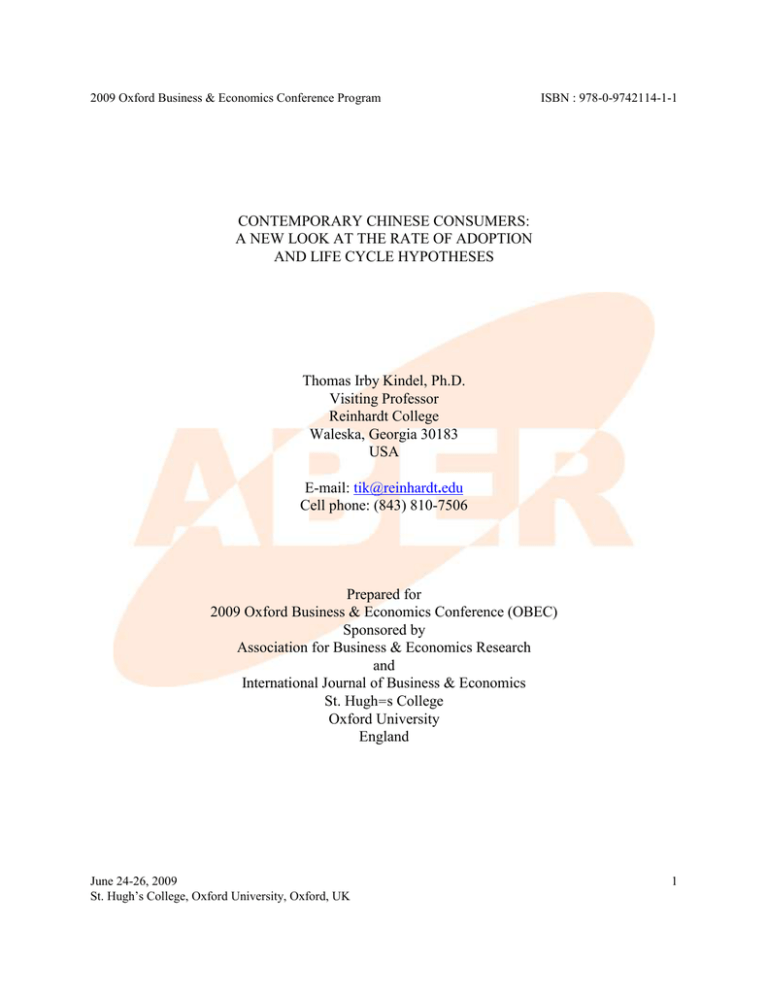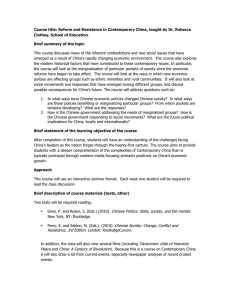Contemporary Chinese Consumers: A New Look At The Rate Of Adoption And Life Cycle Hypotheses
advertisement

2009 Oxford Business & Economics Conference Program ISBN : 978-0-9742114-1-1 CONTEMPORARY CHINESE CONSUMERS: A NEW LOOK AT THE RATE OF ADOPTION AND LIFE CYCLE HYPOTHESES Thomas Irby Kindel, Ph.D. Visiting Professor Reinhardt College Waleska, Georgia 30183 USA E-mail: tik@reinhardt.edu Cell phone: (843) 810-7506 Prepared for 2009 Oxford Business & Economics Conference (OBEC) Sponsored by Association for Business & Economics Research and International Journal of Business & Economics St. Hugh=s College Oxford University England June 24-26, 2009 St. Hugh’s College, Oxford University, Oxford, UK 1 2009 Oxford Business & Economics Conference Program ISBN : 978-0-9742114-1-1 CONTEMPORARY CHINESE CONSUMERS: A NEW LOOK AT THE RATE OF ADOPTION AND LIFE CYCLE HYPOTHESES Abstract Chinese consumers have changed over the past several decades as China has become more involved with the world of global business. A significant percentage of Chinese have become more educated, have increased disposable income, and access to the internet. The basic motivations and life styles which were evident in the 1980’s for the Chinese people have been altered such that their consumption behaviors in the 21st century are also changing. This paper specifically identifies the causes of the behavior changes and puts forth a group of hypotheses to represent the contemporary Chinese consumer regarding their rate of adoption of new products and the product life cycle itself. The paper concludes with a set of recommendations for businesses who want to appeal more successfully to the contemporary Chinese consumer. Preface to this Paper The author of this paper has devoted the past quarter century to working with both Chinese and other asian firms as a consultant. In addition he has taught in several major business schools in Asia. His initial model of consumer behavior (1982) has been quoted extensively over the years. This paper is the second in a series that up-dates the original June 24-26, 2009 St. Hugh’s College, Oxford University, Oxford, UK 2 2009 Oxford Business & Economics Conference Program ISBN : 978-0-9742114-1-1 model given the realities in China in the 21st century. Significance of the Chinese Market With a population of about a billion and a quarter people, the People=s Republic of China is an enormous consumer market attracting the attention of businesses around the world. To the demographic size we can add the annual rate of growth of the gross domestic product, which has averaged better than seven percent for the past two decades, and realize the great potential for both consumer and industrial demand as it increases from year to year. Several additional points of importance include the tremendous rise in consumer aspirations over the years, the emphasis on modernization of the nation, the continued increase in the population base, and the >opening-up= of the society to ideas as well as products and services from other countries. The result is a country which has made an almost unimaginable leap forward especially in economic terms as they join the capitalist world of global trade. Importance of Studying Chinese Values As global firms try to penetrate into the enormous Chinese market, the question arises regarding how to understand the Chinese consumer. Do we simply use demographics to assess and understand the market? Or, do we use a >trial and error= approach? Are the Chinese consumers similar to consumers in the West? Based on several decades of experience in the Chinese world, this author feels that the >key= to enhancing the probability of success in entering the PRC market is to study the >values= of the consumers as a guide to their consumption patterns. This view is reinforced by the work June 24-26, 2009 St. Hugh’s College, Oxford University, Oxford, UK 3 2009 Oxford Business & Economics Conference Program ISBN : 978-0-9742114-1-1 of Kassarjian and Robertson who wrote that AThe impact of culture on behavior, including consumption behavior, is not always well recognized.@ The experience of this author regarding the importance of cultural values to understand consumer behavior is also echoed by renown writers John Howard and J. Sheth. This author strongly suggests that understanding how the cultural values of Chinese drive their consumption behavior is a clear way toward a firm gaining a >competitive advantage= in the PRC market. The Original 1982 Classical Values of the Chinese The classical Chinese values which have existed for over two thousand years include social-consciousness, family ties, mutual dependence, high moral values, hierarchical systems, harmony, the status quo, development of a social self rather than a private self and pragmatism. The original hypotheses involving rate of adoption of products and services plus those on the product life cycle are listed here, in part: <Note that all of the hypotheses compare the Chinese consumer with Western consumers.> 1. There is a lower percentage of innovators and early adopters among Chinese. 2. The rate of adoption will be slower. 3. Simplicity both in product design and function will be accepted more quickly than complexity. 4. Radically different products or futuristic ones will be much slower in acceptance. 5. The overall product life cycle is likely to be much longer in duration once the product is established. 6. The introductory stage is likely to be much slower. June 24-26, 2009 St. Hugh’s College, Oxford University, Oxford, UK 4 2009 Oxford Business & Economics Conference Program ISBN : 978-0-9742114-1-1 21st Century Realities in the People’s Republic of China The changes in the Chinese world in the past quarter century are enormous and have a strong influence on how Chinese consumers think and act in the marketplace. This is not to suggest that all Chinese have abandoned the classical values and their influence; however, certain segments of the population- called >contemporary= Chinese- have new outlooks on life and their purchasing decisions are different than would be the case in the >old days.= The 21st century realities (changes) include the following: * A great increase in the number of young Chinese. * Mass movement to the urban cities and away from the rural lifestyle. * Large increases in disposable and discretionary incomes. * Use of the internet to receive outside information and viewpoints. * Exposure to advertisements and other promotion from the large multinational firms. * Increased education for the masses, particularly in the cities. * Overseas travel. * A more >open= society. Up-dated Hypotheses for the ‘Contemporary’ Chinese <Note that the hypotheses below are relevant for the segment of Chinese consumers- identified as >contemporary=- who have experienced the >realities= listed above.> 1. There is a major increase in the percentage of Chinese consumers who are innovators and early adopters (meaning a willingness to try new products and services before they are accepted by the majority of the target market). 2. The rate of adoption of products will be much faster for the contemporary Chinese. 3. Those Chinese who have experienced the >realities= of the 21st century will purchase even the most sophisticated and complex products. 4. Radically different and futuristic products will be awaited for and purchased by the contemporary Chinese. 5. The overall product life cycle will be much shorter in duration for modern products as the contemporary Chinese is willing to try newer models as they appear. June 24-26, 2009 St. Hugh’s College, Oxford University, Oxford, UK 5 2009 Oxford Business & Economics Conference Program ISBN : 978-0-9742114-1-1 6. The introductory stage of the product life cycle is considerably shorter for the contemporary Chinese. Responses for the Multinational Business Community The firms which want to successfully penetrate the PRC market must first clearly identify their target market. To the extent that their target market has not been particularly involved in the new realities, then the behavior of this segment can be understood and serviced by study of the original >classical= Chinese values and how they possibly influence purchasing decisions of consumers. For the large number of Chinese who are now labelled as >contemporary= consumers, business must adjust their strategies in order to enhance their probability of success. Specific strategies in servicing the >contemporary= Chinese consumers include, in part, the following: 1. Presentation of modern products but presented in a culturally-sensitive manner to include an acceptable product name for products that do not have a world brand. 2. Presentation of world-famous brands to appeal to the up-scale contemporary Chinese. 3. A strategy of making frequent >up-grades= in the product features. 4. Introduction of a wider and deeper product mix to satisfy individual demand. 5. Use of promotional appeals that are as much emotional as functional. 6. Use of advertising that appeals to the individual Chinese consumer without reference to any need for group acceptance prior to purchase. 7. Utilization of a more >hard-sell= approach to the individual Chinese consumer. 8. Use of more flamboyant packaging. 9 . An expectation that the product life cycle will be much shorter for contemporary Chinese. June 24-26, 2009 St. Hugh’s College, Oxford University, Oxford, UK 6 2009 Oxford Business & Economics Conference Program ISBN : 978-0-9742114-1-1 10. Use of advertising and other promotional media to accelerate the introductory stage of the product life cycle. In Conclusion The new realities within the People=s Republic of Chinese suggest that business strategies for multinational firms must be altered significantly to gain quicker acceptance of the products and services in the target markets identified as >contemporary= Chinese. June 24-26, 2009 St. Hugh’s College, Oxford University, Oxford, UK 7





